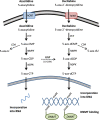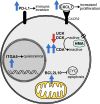Hypomethylating agents (HMA) for the treatment of acute myeloid leukemia and myelodysplastic syndromes: mechanisms of resistance and novel HMA-based therapies
- PMID: 33958699
- PMCID: PMC8257497
- DOI: 10.1038/s41375-021-01218-0
Hypomethylating agents (HMA) for the treatment of acute myeloid leukemia and myelodysplastic syndromes: mechanisms of resistance and novel HMA-based therapies
Abstract
Aberrant DNA methylation plays a pivotal role in tumor development and progression. DNA hypomethylating agents (HMA) constitute a class of drugs which are able to reverse DNA methylation, thereby triggering the re-programming of tumor cells. The first-generation HMA azacitidine and decitabine have now been in standard clinical use for some time, offering a valuable alternative to previous treatments in acute myeloid leukemia and myelodysplastic syndromes, so far particularly in older, medically non-fit patients. However, the longer we use these drugs, the more we are confronted with the (almost inevitable) development of resistance. This review provides insights into the mode of action of HMA, mechanisms of resistance to this treatment, and strategies to overcome HMA resistance including next-generation HMA and HMA-based combination therapies.
Conflict of interest statement
ML has received research funding and travel support from Janssen-Cilag, study drugs from TEVA, Cheplapharm and Aristopharm, and compensation as a member of the scientific advisory board of Janssen-Cilag and Astex. All the other authors declare no potential competing interests.
Figures



References
-
- Robertson KD. DNA methylation and human disease. Nat Rev Genet. 2005;6:597–610. - PubMed
-
- Gruenbaum Y, Cedar H, Razin A. Substrate and sequence specificity of a eukaryotic DNA methylase. Nature. 1982;295:620–2. - PubMed
-
- Okano M, Bell DW, Haber DA, Li E. DNA methyltransferases Dnmt3a and Dnmt3b are essential for de novo methylation and mammalian development. Cell. 1999;99:247–57. - PubMed
-
- Sorm F, Piskala A, Cihak A, Vesely J. 5-Azacytidine, a new, highly effective cancerostatic. Experientia. 1964;20:202–3. - PubMed
Publication types
MeSH terms
LinkOut - more resources
Full Text Sources
Other Literature Sources
Medical

